Facts About Meteors and Meteorites
Posted by Admin / in Science Facts
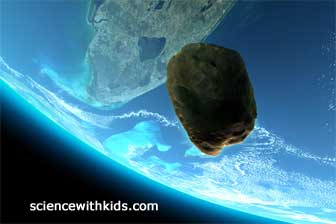
Some meteors that enter the Earth's atmosphere are quite large. A meteor that reaches the Earth's surface without burning up is known as a meteorite.
Facts About Meteorites
- Meteorites are solid particles that fall to the Earth's surface from space passing through the Earth's atmosphere
- Most meteorites that reach the Earth's surface are only the size of dust.
- Scientists estimate that 100,000 metric tons (110,000 tons of solid material) falls to the Earth each year because of meteorites.
- Many meteorites likely come from asteroids.
- Most known asteroids in our solar system are located between Mars and Jupiter. There are more than 1600 known large asteroids in this region. Asteroids collide with each other. Scientists think that asteroid fragments make their way to planets and moons within the solar system. When these asteroid fragments pass through our atmosphere and strike the Earth, they are known as meteorites.
Facts About Meteors
- Meteors are solids that enter the Earth's atmosphere, but have not reached the Earth's surface.
- Meteors are sometimes called shooting stars. They are not stars. The light streaking across the horizon is a meteor burning up as it enters the Earth's atmosphere.
- Scientists believe the Earth's atmosphere is bombarded with thousands of 100 ton meteors every 10 years.
- Over an average 10 year period, scientists estimate 100+ 1000 ton meteors will enter the Earth's atmosphere.
- Over this same time period, scientists estimate at least ten 17,000 ton meteors will enter the Earth's atmosphere.
- Scientists also believe that over a ten year period at least one 110,000 ton (100,000 metric ton) meteor will enter the Earth's atmosphere.
Meteorites That Left an Impact
There are some famous meteorites. When people find meteorites they often treat them as special objects. Chinese, Greek, Hebrew and Romans have all recorded sightings of meteors. Meteorites have also been found in Indian burial grounds in North America.
- The Barringer Meteorite, also known as Meteor Crater, named after a Philadelphia mining engineer and attorney Daniel Moreau Barringer, is one of the most famous meteorites because of the crater it left behind. Located in Northern Arizona, the meteorite that hit is estimated by scientists to have a width of 130 feet. The estimated speed of the meteorite before it hit the Earth is 26,000 miles per hour. The meteorite left behind a huge crater almost 1 mile (1.6 km) wide and 570 feet (173 meters) deep. The meteorite exploded on impact and the remnants of the meteorite are scattered around the crater. The crater is very well preserved because of the dry desert conditions.
- The largest single meteorite found on Earth is the Hoba Meteor. It was found by a farmer in Nambia, Africa in 1920. The current size of the Hoba Meteorite is 9 feet by 9 feet by 3 feet. The meteorite weighs about 66 tons. It likely survived because it is metal, containing a majority of iron and about 16% nickel.
- Scientists have found over 40 meteorite craters on earth that are larger than 12 miles (20 km) in diameter. The largest meteorite crater found on earth that scientists agree was formed when a meteorite struck the Earth is the Vredefort Dome, located in South Africa. The crater was over 180 miles in diameter (300 km). Today because of erosion and sediment, the crater size is now smaller.
- With the amount of video recording devices such as cell phones and surveillance video now available more meteors are being caught on film. In 2013 a large meteorite was recorded in Eastern Russia. The meteorite was actually recovered from a frozen lake and is one of the largest meteorites found.
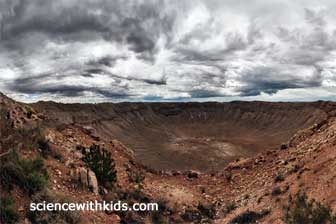
Landscape view of the Barringer Meteor crater near Winslow, Arizona
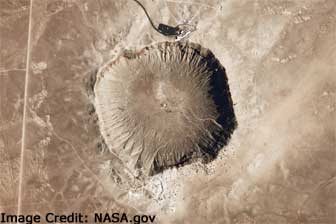
Aerial view of the Meteorite Crater near Winslow, Arizona
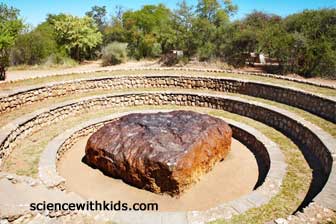
The Hoba Meteorite is the largest meteorite found on Earth. It is located in Namibia, Africa.
Interesting Facts about Meteors and Meteorites
- There are thousands of known meteorites that have been found on the Earth's surface. Since so many meteorites fall on the Earth's surface each year you may think that this number would be much higher. Meteorites are difficult to find because most are too small to notice. Unless people see them hit the ground or find an impact crater, meteorites are not particularly noticeable. Also, a majority of meteorites hit the oceans or areas with a lot of vegetation and trees, making them very difficult to locate.
- Scientists, including geologists, once thought that all craters on Earth were a result of volcanoes. A volcanic crater or caldera is a similar shape caused by venting or the location where a volcano erupts. The first crater that was accurately identified as one formed from the impact of a meteorite, was the Barringer Meteor Crater, first identified by Daniel Barringer.
- With so many large meteorite craters on Earth over 1 mile in diameter, no impact and creation of one of these craters has been recorded in modern history.
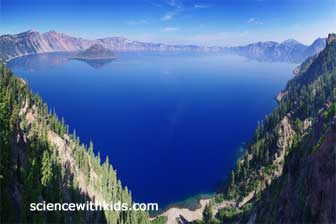
Crater Lake in Oregon looks like a meteorite crater, but it is actually a crater resulting from a volcano.
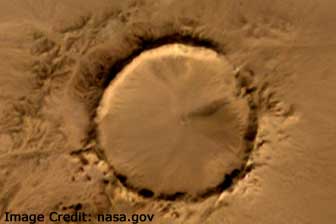
The Tenoumer Crater was discovered in the Sahara Desert. It has a crater diameter over 1 mile wide with an elevated rim that rises 300 feet (100 meters) above the desert.
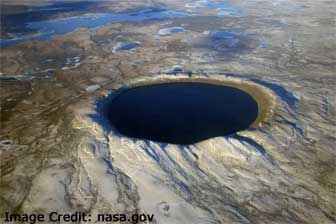
There are two large craters in the Northern part of Quebec in the Ungava Peninsula. The Pingualuit crater at 2 miles in diameter and a depth over 800 feet is the smaller of the two craters. The larger crater is the Couture Crater at over 5 miles in diameter.
